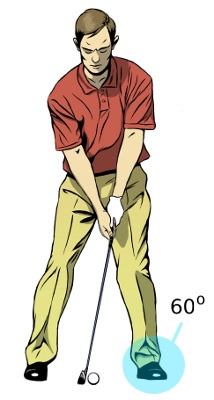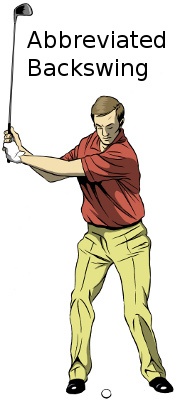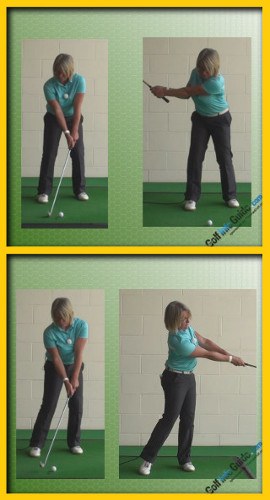 When the weather gets windy, pro golfers have to go-to a shot for keeping the ball low.
When the weather gets windy, pro golfers have to go-to a shot for keeping the ball low.
It's called the knock-down, and it's a handy weapon for any golfer's arsenal.
The golf knock-down shot, sometimes called a “punch” shot, flies with a low, penetrating trajectory that limits the wind's effect. Played into a headwind, a knock-down won't balloon up into the air and lose distance like a higher shot. The knock-down's boring flight is less susceptible to crosswinds, too.

What's more, the knock-down can be used for other situations, such as playing under tree limbs or running the ball onto a green.
Here's how to hit a knock-down with an golf iron:
1. Take your stance with the ball positioned in the middle or just right of center (for right-handers) and your hands well ahead of the ball.
2. Your balance should favor the left side, but only a little (no more than 60-40).
3. Make a slightly abbreviated backswing.
4. Swing through, being careful not to overswing. An easy swing will keep the ball down with minimal spin.
It's also possible to hit a knock-down with the driver. Tee the ball so that the top is just above the club's crown, play it a few inches back of your normal position, and make a smooth, compact swing.

What is a Knock Down Golf Shot?
There are a number of different shots that are needed if you are going to move your ball around the course successfully round after round. Golf would be relatively easy – and pretty boring – if you could just hit the same kind of shot all the time. It is the variety of the game that makes golf interesting, but it also means that you need to be well-prepared to hit all of the various shots necessary. Many golfers struggle for years just to hit a 'standard' shot, so they never move on to working on adding variety to their games. This is a mistake. Even if you don't yet have great control over your full swing, you should still work on learning how to hit other shots during your practice sessions. These shots will not only help you get your ball around the course, but they may also help you discover changes that need to be made to your full swing.
One of the important shots that you should learn at some point in your golf career is the knock down shot. Basically, this is a shot that is hit lower than normal, and it can be hit with just about any club in the bag (except the putter, obviously). A knock down shot is often used in windy conditions, but there are other situations that call for it as well. If you watch any professional golf on TV, you will see the knock down used on a regular basis, even when the wind isn't blowing. As far as modified ball flights go, this is one of the most important, and one of the first shots (other than a standard shot) that you should learn to hit.
You will be happy to learn that the knock down shot is actually relatively easy to learn, and you can get comfortable with it in a short period of time. Many of the other 'specialty' shots in golf take a long period of time to learn, but that is not the case with the knock down. The basic pattern of the swing is the same as it is for any other shot, so you won't be making large mechanical adjustments in order to hit a knock down. By simply tweaking a few things in your setup and swing, you can move your ball flight lower with relative ease.
It is best to think of the golf course like a puzzle. If you are going to solve the puzzle successfully on a regular basis, you need to have all of the pieces in your possession. The standard golf shot is certainly one of the most important pieces to the puzzle, but the other specialty shots are important as well. The more pieces you can add to your collection before you walk out to the first tee, the better chance you will have of actually solving the puzzle.
All of the instruction below is based on a right handed golfer. If you happen to play left handed, please take a moment to reverse the directions as necessary.

When to Use a Knock Down Shot
Before you take the time to learn the knock down shot, it would be wise to understand when it is that this shot will come in handy. After all, if you aren't going to have occasion to use the shot on the course, there is no reason to learn how to hit it in the first place. After reading the list below, you should have a clear picture of just how important – and useful – this shot can be.
- Windy conditions. As mentioned above, the knock down shot is particularly useful when playing shots in the wind. It is not only used on into-the-wind shots, however – it can be pulled out of the bag anytime wind is a factor. If you toss the ball up high into the sky on a windy day, there is really no way of knowing when or where it is going to come down. The wind is simply too unpredictable, and too hard to read from ground level, to judge accurately on a high shot. Therefore, using the knock down in the wind is a great idea. By keeping the ball lower to the ground, you can take out some of the guesswork and produce more consistent results. In addition to the lower flight, a knock down shot will have a lower spin rate, meaning the wind should have less of an effect over its trajectory. If you play golf in a place that tends to be windy, you really have no choice – you are going to need to learn the knockdown if you want to post good scores.
- Narrow target. One of the other advantages of a knock down shot is its ability to hold the target line from impact until it comes down out of the air. When you keep the ball low to the ground, it is easier to keep it on line – meaning you can narrow your margin for error, which is a good thing if hitting to a tight target. For instance, if you are hitting an approach shot to a narrow green that is guarded by bunkers or even water, consider hitting a knock down shot to reduce the chances of missing to the right or left. When you throw the ball high in the air, it has more time to turn to either side as it falls, making you less accurate as a result. If you get comfortable and confident with the knock down, you can use it to aggressively attack small targets without the fear of running into trouble.
- Back hole location. Getting the ball close to a back hole location is a particularly tricky task. While you certainly want to be aggressive with your approach shots to set up birdie chances, you also don't want to get too aggressive and wind up in trouble. This is a concern to a back hole position, where a shot that flies just a few yards too far could go over the green and leave you with an impossible up and down. So, instead of flying the ball all the way to the back, you could consider hitting a knock down shot which lands in the center of the green and bounces back toward the target. This is a safer option because there is almost no chance of flying the ball over the green, and even if it bounces over, it will only be just off the edge and your chip should be relatively easy. This is one of the very best uses for a knock down shot, and you should find that you have more birdie chances if you learn to deploy the knock down when the hole is near the back edge.
- Pressure situation. The final circumstance on our list is one you might not have previous considered when thinking about the knock down shot. When you find yourself in a pressure situation on the course – such as late in the round during a competitive match at your club – you could turn to the knock down as a way to keep the ball in play and on track. Your swing is harder to execute properly when you are nervous, so making a smaller swing and hitting a lower shot simply cuts down the number of things that can go wrong. Taking this option doesn't mean that you will be immune to pressure, but you will have a better chance of producing a quality shot while feeling the nerves.
As you can see, there are plenty of chances on the golf course to use your knock down shot. This list is incomplete to be sure – you will likely find even more than just these four circumstances during which you can use the knock down to position the ball successfully. Of course, you have to know how to hit the shot before you can put it into action, so the next section will deal with the specifics of executing a solid knock down swing.

The Basics of the Knock Down
As you would imagine, the process of learning the knock down shot begins on the driving range. Without spending some time practicing this shot on the range, you will have essentially no chance to execute it correctly on the course. To integrate this shot into your game, consider hitting five or ten knock downs as part of each practice session you complete. By dedicating a small amount of your session to hitting knock downs, you will quickly become comfortable with the shot and you will be able to pull it off on command out on the golf course.
The swing that you make for a knock down shot shouldn't change dramatically from the swing you make to hit any other kind of shot. In fact, if you make too many changes, you won't be able to execute both your knock down swing and your regular swing properly within the same round. When working on your knock down shots on the range, try making the following changes to your swing.
- Move the ball back in your stance. Any time you want the ball to fly lower, you need to move the ball back in your stance. That is true no matter what kind of shot you are hitting, and it certainly applies to the knock down. It is important, however, that you don't move the ball too far back. If you put the ball all the way back by your right foot, your swing will become too steep and you will have trouble making solid contact. The best way to establish ball position for the knock down is to take your stance with the ball in its normal position based on the club you are hitting, and then move it back just an inch or two from that point.
- Choke down on the grip. The next step in this process is to choke down on the grip of the club. You want to take speed out of your swing when you are hitting a knock down, and coming down an inch or two from the top of the grip is a great way to do that. Even if you make your normal swing with a full shoulder turn, your swing speed will still be reduced due to the smaller arc of the club going back and through. You can also 'customize' this point based on the exact flight you are looking to achieve – only choke down slightly for a moderate knock down, or choke way down for a shot that flies extremely low and much shorter than normal.
- Narrow your stance. To make it easier to make a 'tight' golf swing, you should stand with your feet slightly closer together than you would on a full shot. Again, this should not be a dramatic change. Move each foot in by just an inch or so and you will find yourself standing up taller. It is harder to make a big shoulder turn from a narrow stance, so your swing should naturally shorten up when you make this adjustment – which is perfect for creating a knock down shot.
- Stand closer to the ball. With your hands moved down the grip, you are going to need to stand slightly closer to the ball than you would when using the whole club. This is an easy point to forget, but it is extremely important if you want to execute the shot properly. Should you choke down on the club but forget to move closer to the ball, a pull or a hook is the likely outcome.
- Stay right on top of the ball. This actually isn't much of a change from your full swing, as you should be trying to stay balanced throughout your swing under any conditions. However, it is worth highlighting here that it is crucial for you to stay right over top of the golf ball while hitting a knock down shot. During your backswing, be sure to avoid the temptation of sliding to the right and away from the target. Your weight should remain balanced between your feet during the backswing so you can move aggressively into the downswing from the top.
Those five points might seem like a lot to remember, but they will quickly become second nature after a short period of practice. If necessary, right each of these points down on a card and put that card in your pocket before your next practice session. Once you review your checklist a few times on the range, you will probably be able to throw the card away.

Making Adjustments
If you are an experienced golfer, you already know that nothing comes easy on the course. If you are relatively new to the game, you will learn that lesson soon enough. The game of golf is one of the most difficult in the world, and you are going to have to earn everything that you get. What that means for your knock down shot is that you shouldn't expect it to be an instant success. It is true, as was mentioned earlier, that learning a knock down is easier than some other shots you can try to add to your repertoire. However, that doesn't mean it is easy. You will still have to work, and you will still have to go through some rough patches along the way.
Following is a list of a few of the problems you could be fighting while learning the knock down. If you are struggling, find the relevant point on the list below and use the instruction to get back on track.
- Pulling the ball to the left. This is a relatively common problem to experience when learning how to hit the knock down. It is generally caused by a lack of rotation in the lower body. Knowing that you are trying to hit the ball softer than usual, you may feel like you can't use your legs as you normally would – so they end up standing still while you swing your arms. The lack of lower body turn means the club face winds up shut at impact, and the ball misses the target to the left. To fix this issue, make it a point to use your legs just as you do for all shots. Since you made other adjustments (such as choking down and moving the ball back in your stance), you should be able to use your lower body turn throughout the ball without hitting the shot too hard.
- Hitting the ball fat. When you start to hit your knock down shots fat, you will know that your downswing has gotten too steep. Most likely, this has happened because you moved the ball too far back in your stance. Check your address position carefully to make sure the ball is only an inch or two back from its normal position. Once your ball position is corrected, you should find that you are able to make clean contact once again.
- Making poor contact. Some players simply struggle to square the ball up on the middle of the club face. They won't necessarily have a pattern to their misses – they just won't be able to find the sweet spot with any kind of consistency. If that sounds like you, the likely cause is a rushed backswing. When you know you are going to make a shorter-than-normal backswing, it is easy to rush it with a quick tempo. Do your best to avoid that mistake. Instead, stick with your usual tempo and allow the pre-shot adjustments you made create the knock down flight you desire.
Practice is the best remedy for just about any issue you have in golf. If you are struggling with the knock down shot, hit more of them on the range and discover the solutions through those repetitions. Of course, the tips above may be helpful as well, so consider them as you try to work your way through the process of developing a reliable knock down.

Pulling the Trigger
It is one thing to learn how to hit a knock down shot on the range – it is an entirely different thing to decide to give it a shot on the course. You might be hesitant at first to call upon your knock down after just having learned it in a practice session. Of course, the only way to gain confidence is to give the shot a chance to perform during a round. Pick a spot where you aren't feeling any pressure and there is nothing on the line to test it out on the course and see what kind of results you are able to achieve. You will learn a lot from those first few attempts, and from there you can refine your technique until you are happy with the ball flight this swing gives you.
If you are fortunate enough to be able to play a lot of golf, you should consider playing an entire round where you hit nothing but knock down shots. This might not be the best strategy for your score, but it is a great way to quickly get comfortable with this type of shot. Pick out a round where you are either playing by yourself or playing with some good friends, and make nothing but knock down swings from the first hole to the last. You are bound to hit at least a few good ones over the course of 18 holes, and you will likely have greatly improved confidence in the shot during your next 'normal' round.
Having the ability to hit a knock down shot is an important skill to develop, but it is one that is ignored by many amateur golfers. A knock down shot is actually pretty easy to hit, as long as you follow the basic instructions included above. Make this type of shot a priority during your practice sessions and it will quickly become one of your go-to weapons on the course.






